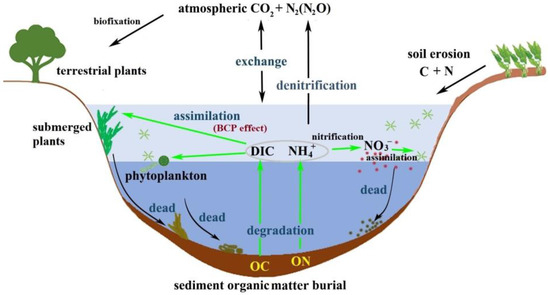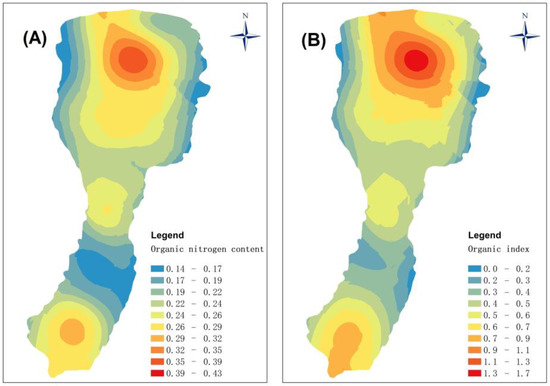You're using an outdated browser. Please upgrade to a modern browser for the best experience.
Please note this is an old version of this entry, which may differ significantly from the current revision.
Subjects:
Environmental Sciences
Sedimentary organic matter is an important component of the metabolism of a lake’s ecosystem, and it is generally derived from both the watershed and the primary productivity of a lake. Understanding the sources of organic matter in lakes and lake trophic status is important when evaluating the quality of lake ecosystems.
- lake ecosystems
- surface sediments
- organic matter sources
- carbon isotopes
- distribution characteristics
1. Introduction
With global climate change, the greenhouse effect has led to an increase in CO2 in the atmosphere and caused a large increase in primary production in inland lakes [1]. Although many studies believe that freshwater systems are CO2 sources [2], this is not always the case (including but not limited to): (1) While the dynamic equilibrium of a water body CO2 depends on the physical process, the diffusion rate is only one in ten thousand of that in the atmosphere [3]; (2) A unique physiochemical characteristic of karst water is that its CO2 concentration falls below 1% of dissolved inorganic carbon (DIC) when the pH level exceeds 8 [4]; (3) There are large amounts of recalcitrant dissolved organic carbon in karst aquatic ecosystems (decreased release of carbon compounds) [5]; (4) Carbon cannot meet the growing demands of highly eutrophic lakes [6]; and (5) CO2 can be seasonally and locally depleted when photosynthesis occurs [4]. Therefore, the problem of carbon sinks in terrestrial aquatic ecosystems deserves further attention.
Researchers have found that atmospheric CO2 can be converted into organic carbon via a series of physical, chemical, and biological processes and can be buried in sediments [7,8,9,10]. Compared to allochthonous sources [11], the organic matter (OM) component produced in situ by aquatic plants is termed autochthonous [9]; this OM is synthesized from dissolved CO2 (CO2aq), either photosynthetically or chemosynthetically, by submerged macrophytes, algae, and other microbial organisms. If the resulting autochthonous OM is deposited and buried in lake sediments, it can remove carbon from the short-term carbon cycle and form long-term stable carbon storage, which is similar to the marine biological carbon pump (BCP) effect [12]. Recent studies have revealed a BCP effect in which aquatic photosynthesis takes up DIC derived from carbonate weathering, and part of the generated autochthonous organic carbon is buried [5,9,10,13,14,15,16]. Researchers have presented the carbon sink mechanism of the carbonate-weathering-derived carbon sink coupled with aquatic photosynthesis (coupled carbonate weathering (CCW)), which indicates that carbonate weathering can form long-term effective carbon sinks via organic carbon burial [14,17].
Lakes are a significant component of terrestrial ecosystems, and their sediments provide a rich archive of information on the environmental history of lake watersheds [7,8]. The organic matter (OM) component of lake sediments is widely used to reconstruct paleoclimates and paleoenvironments, and to evaluate the anthropogenic impacts on local and regional ecosystems [9]. The transport of OM to lakes is a significant link in the global carbon cycle [10]. In addition to the significant part of the OM of lake sediments in terrestrial aquatic ecosystems, its significance is also reflected in its participation in nutrient cycles and the regulation of lake ecosystems [18]. As shown in Figure 1, contemporary anthropogenic activities such as land-cover changes and agricultural land-use have resulted in increased carbon (C) and nitrogen (N) discharge from soils into freshwater ecosystems [19,20,21,22], and thus strongly influenced the patterns of organic carbon (OC) input and trophic status [15,16]. Therefore, nutrient metabolism and the associated biogeochemical cycles are tightly coupled with aquatic photosynthetic production. It is well-known that in the transformation and flux of C and N, the main carrier is sedimentary organic matter [7]. In lake aquatic ecosystems, there is a coupled relationship between the water column and biogeochemical cycling in surface sediments [23]. Nutrients recycled within the sediments are liberated and subsequently diffused, and can then be supplied back to the overlying water and affect primary production via a somewhat complicated network of microbially-mediated biochemical reactions (Figure 1) [24].

Figure 1. Schematic diagram showing the biogeochemical cycles influencing the organic matter of lake sediments.
2. Significance of the Spatial Distribution of Organic Matter Sources in Lake Sediments
Surface lake sediments have long been considered as the main reservoir of OM, buried in terrestrial aquatic ecosystems. Lakes, especially carbonate lakes, are an important carbon sink in terrestrial ecosystems [8]. The large-scale buried OM in sediments is largely accomplished by the coupling of high sediment deposition/accumulation rates [8] and high storage efficiency, which is 50 times greater than the ocean on average [25]. For lakes, especially large lakes, with complex sedimentary environments, it is important to recognize the spatial distribution of sediments and their composition when assessing a lake’s biogeochemical cycles; this is because the concentration and source may be spatially heterogeneous [26]. In addition, large quantities of nutrients may be released from fine-grained organic sediments at specific locations within the water body [27]. Therefore, it is necessary to map the distribution of sediments and their nutrient composition to create a spatially continuous surface in order to determine specific locations that will be targeted in the restoration of eutrophic lakes.
Various regional studies have confirmed the spatial heterogeneity of the organic components of lake sediments (e.g., in Australia (Coombabah Lake [23]), Asia (Nam Co Lake [28]), Europe (Sarbsko Lake [29]), and America (Pyramid Lake [30]). Numerous factors may influence the quantity of OM including the influx of terrestrial OM to the lake, aquatic productivity, various sediment properties, redox conditions, and the rate of microbial activity [23]. Generally, contributions from allochthonous and autochthonous OM, namely, from aquatic and terrestrial sources, have a direct–indirect impact on the spatio-temporal distribution of OM [26,29]. Thus, differentiating autochthonous and allochthonous sources of OM is a significant first process when evaluating the OM content of lake sediments.
3. Application of Tracer Methods in Determining the Sources of OM in Lake Surface Sediments
The diversity of OM sources depends not only on the biogeochemical characteristics of the lake watershed, but also on the social development status of urbanization and industrialization. Due to the large number of sinks and sources of OM in lake sediments, as above-mentioned, determining the constraints on its distribution is a challenging task [31]. However, as the major active component, OM is ultimately derived from allochthonous sources (terrestrial plant debris) or autochthonous sources (in situ primary production) in aquatic systems. Multiple bulk sediment parameters and molecular biomarkers have long been used to clarify the source of OM including C/N (atomic) ratios, stable organic carbon isotope ratios of OC (δ13Corg) [32], molecular biomarkers [33], and the combined use of stable carbon isotopes (δ13C) and radiocarbon isotopes (Δ14C) in sediments [34].
Any tracer method has its specific attributes including flaws. Essentially, the utilization of various parameters as source indices relies upon different OM sources having markedly different signatures. Conventional geochemical methods (e.g., δ13Corg and C/N) have often been used to clarify the sinks and sources of OM within lacustrine environments [35]. The C/N molar ratios of bacteria, terrestrial plants, soil, phytoplankton, and aquatic macrophytes fall within a specific range [36]. In general, phytoplankton contain more proteins but are low in fiber, and the molar ratios are usually less than 10 [35]; the protein contents of emergent macrophytes and terrestrial plants are generally low, but the fiber contents are rich, which leads to a relatively high C/N molar ratios (>20) [35]. The study found that the C/N molar ratios of phytoplankton vary from 5 to 8, with an average of ~6 in submerged plants of 12 or more [36]. The δ13Corg values for C4 plants fall between −17% and −9%, while that of terrestrial C3 plants is relatively negative, between −32% and −20% [35]. Macrophytes have more positive δ13Corg values (−30% to −5%) due to their C4-like photosynthesis pathway [37], while phytoplankton have relatively low δ13Corg values (−42% to −20%) due to C3-like photosynthesis, which leads to a large degree of δ13C fractionation [38]. Microbial sources (e.g., bacteria) in lake sediments can be indicated by their low δ13Corg values (−26%) [39]. However, the δ13Corg values are influenced by various environmental factors that may lead to ambiguous and overlapping signatures, and C/N is directly affected by the mineralization of OM. Nevertheless, Wilson et al. (2005) [40] considered that the combined use of C/N molar ratios and δ13Corg was an effective means of identifying OM sources. In general, the combined use of multiple indices can be expected to increase the degree of accuracy when determining the source of OM.
We compiled research on the sources and composition of OM in the surface sediments of Fuxian Lake, the largest lake, and a karst rift lake at the source area of the Pearl River. Although Fuxian Lake is oligotrophic, several studies have shown that it is at risk of becoming polluted [41]. Several previous studies have been conducted on the source, migration, and transformation processes and mechanisms of OM in Fuxian Lake [20,42] as well as on the stability of a carbonate weathering carbon sink [6,9,13]. In order to clarify the impact of anthropogenic activities and regional environmental parameters on the ecosystem of Fuxian Lake, we analyzed the spatial distribution characteristics of TN, TOC, δ13Corg, and C/N in the surface sediments of Fuxian Lake, and we used the results to distinguish the main sources of OM at different water depths to provide a basis for an environmental assessment of the lake.
4. Evaluation of the Nutrient Content of Surface Sediments
Numerous approaches have been used to evaluate the status and health of lake ecosystems. Considering the rapid increase in the accumulation rate of organic matter in the surface sediments of Fuxian Lake, an organic index and the organic nitrogen content of the sediments were used to evaluate the degree of organic contamination, which has been proven to be effective [42,55,56]. The organic index (=Org − C(%) × Org − N(%)) is commonly applied to assess the level of the organic contamination of lake surface sediments, and the organic nitrogen content (TN(%) × 0.95) is an important index for determining the degree to which nitrogen pollution affects the surface sediments of a lake [42,55,56].
The organic index of Fuxian Lake ranged from 0.19 to 1.65, with an average of 0.66. This can be classed as grade IV, which indicates that there is a potential risk of organic pollution. Greater values occurred in the southern marginal area, especially the northern area, which is close to the mouth of one of the major inflowing streams. The organic nitrogen index values were 0.14%~0.43%, with a mean of 0.25%. These results show that there is a serious risk of nitrogen pollution, up to grade IV, throughout the lake, and that the distribution of organic nitrogen content is consistent with that of the organic index (Figure 2). High values occurred in areas of the lake where the catchment is dominated by tourism, agriculture, and forestry, both of which can supply large quantities of allochthonous pollutants, and the deposition of various nutrients and biological residues may be an additional reason for the observed distribution of organic nitrogen pollution. Although modern monitoring shows that Fuxian Lake is an oligotrophic lake and that the contribution of organic matter (mainly, organic carbon) within the lake is mainly autochthonous, there is a potential risk of surface sediments becoming significantly contaminated by organic pollution, especially organic nitrogen pollution. Although this risk has yet to be fully realized, possibly because of the depth of the lake, careful monitoring is required and control measures may need to be adopted in the future.

Figure 2. Spatial distribution of the organic nitrogen content (A) and organic index (B) for the surface sediment samples from Fuxian Lake.
This entry is adapted from the peer-reviewed paper 10.3390/w15040794
This entry is offline, you can click here to edit this entry!
